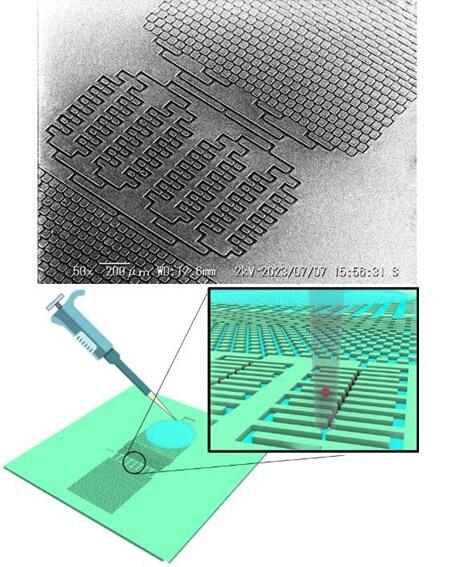A research group led by Professor Hiroaki Suzuki of the Graduate School of Science and Engineering and collaborative Researchers Tomoki Murakami (at the time of the research) and Hiroto Teratani, and Co-researcher Mamiko Tsugane of the Graduate School of Science and Engineering at Chuo University, in collaboration with Aeternus Co. Ltd. and Caravell Inc. announced the development of an open microchannel easy selection and retrieval of single cells based on microfluidics. Open microfluidic channels were used to array single-cell traps. A method was developed to precisely hydrophilize only the inside of cell-sized grooves, enabling cell trapping in open microfluidic channels. Unlike conventional closed microfluidic channels, the trapped cells are exposed on the top surface of the chip and can be easily selected and aspirated using general-purpose robotic picking devices. The findings of this research are expected to lead to the development of screening technology and were published in the international academic journal iScience.

Provided by Chuo University
In recent years, single-cell analysis and manipulation techniques have been developed to study cell properties individually and select cells with high functionality. This task traditionally required the use of advanced image recognition techniques, pipette positioning accuracy and a significant amount of time. To apply the technique of trapping and arraying cells by means of microfluidic channels, the problem of the microfluidic channel being a closed space needed to be overcome.
In the newly developed chip, a drop of liquid at the edge of the channel spontaneously generates a groove flow. If the structure of the microfluidic channel is designed to trap cells and particles, the particles and cells contained in the fluid will spontaneously flow through the channel and become fixed in a predetermined place. Not only can cells be easily arranged without the need for a pump, but the open surface allows the desired cells to be obtained using a glass tube or pipette.
After the cells are precisely arranged on the chip, the system is combined with a table-top robot for aspirating specific cells or clusters of cells using glass capillaries that selectively pick up cells. Two cell trap channel designs, established in a conventional closed channel with a closed ceiling, have been reproduced in an open channel. Observations show that they trap and array cells successfully. This open channel design can be easily transferred to other channel designs.
Suzuki explains, "When playing the card game 'Memory,' it is more efficient to play with cards arranged in an orderly fashion than randomly scattered cards. This new technology can be used to easily and quickly select and remove cells after arranging them neatly. It can be incorporated into machine learning for cell images and drug response testing in the future. Because of this, it is expected to have many applications, including detecting cancer and selecting useful cells."
This article has been translated by JST with permission from The Science News Ltd. (https://sci-news.co.jp/). Unauthorized reproduction of the article and photographs is prohibited.




